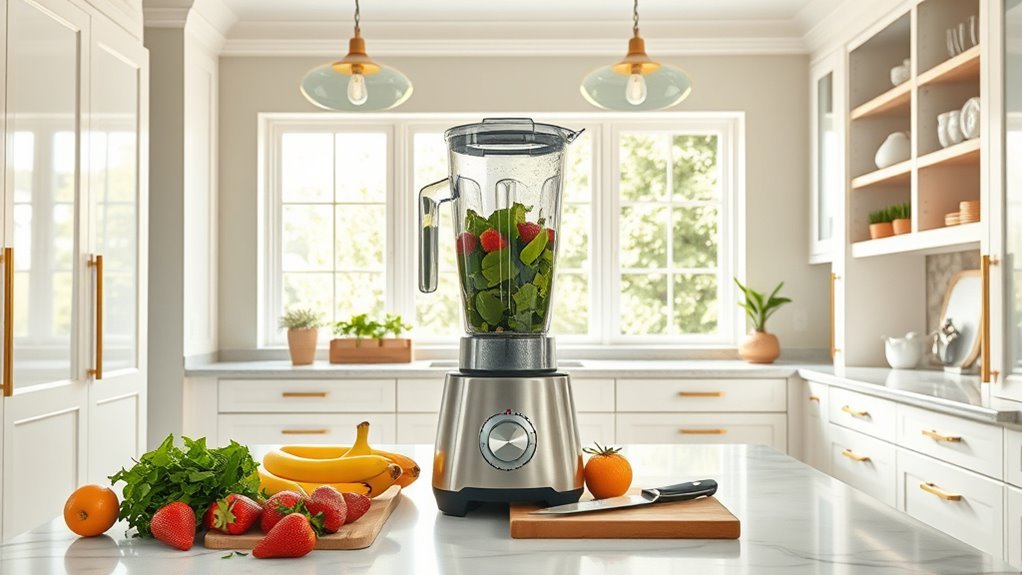We’ve got five essential blender blade types that’ll revolutionize your kitchen game. Multi-prong stainless steel blades crush through smoothies and purees, while cross-cut blades demolish ice at 25,000 RPM. Wing blades master dry ingredients like spices and coffee, flat blades perfect emulsifications, and specialized wet/dry combinations tackle specific tasks. Each design serves a vital purpose – and knowing when to use which blade makes all the difference in your results.
Multi-Prong Stainless Steel Blades for Smoothies and Purees

Powerhouse multi-prong stainless steel blades aren’t just fancy kitchen hardware – they’re precision-engineered vortex creators that transform chunky ingredients into silky-smooth perfection.
We’re talking about blades that mean business, delivering consistent blending performance that’ll pulverize frozen fruits and tough greens into the creamiest smoothies and purees you’ve ever tasted.
What makes these bad boys special? High-performance blenders harness their sharp blades’ impressive RPMs for maximum nutrient extraction. Additionally, high-performance blenders are versatile and can be used for making soups, sauces, and even nut butter.
Plus, they’re built to last – the stainless steel construction keeps them razor-sharp through countless blending sessions. Better yet, they’re easy to clean, thanks to their smart design that prevents ingredient buildup.
Trust us, once you’ve experienced the smooth-blending prowess of multi-prong blades, you’ll never look back.
Cross-Cut Blades for Ice Crushing and Frozen Ingredients
When it comes to demolishing ice and frozen ingredients, cross-cut blades are the heavyweight champions of the blending world.
We’re talking about serrated edges that create a powerful vortex, pulling everything down toward the blades for maximum impact.
You’ll find these powerhouses in high-performance blenders like Vitamix and Blendtec, where they spin at a mind-bending 25,000 RPM.
What’s the payoff? Lightning-fast ice crushing and silky-smooth frozen fruits without drowning them in liquid.
We’re seeing drastically reduced blending time and consistently perfect results.
The blending process is a thing of beauty – these cross-cut blades deliver the consistent consistency we’re after in smoothies and frozen drinks.
They’re specifically engineered to pulverize the toughest ingredients while maintaining ideal texture and flavor. Additionally, these blenders often feature motor power exceeding 1,000 watts, ensuring they can handle even the hardest tasks with ease.
Wing Blade Assemblies for Dry Grinding and Chopping

Unlike their cross-cut cousins, wing blade assemblies take dry ingredients to task with surgical precision.
We’ll find these specialized blades in high-performance blenders, where they excel at dry grinding everything from grains to spices and coffee beans.
What makes wing blades special? Their unique wing-shaped design creates a vortex effect, pulling ingredients directly toward the blades for maximum contact.
This means we’re getting consistent texture in fewer blending cycles – no more starting and stopping to check our progress. When it comes to flavor extraction from spices, these blades outperform standard blade designs every time.
The superior aeration and grinding capability make wing blade assemblies essential for serious dry ingredient processing.
They’re not just another attachment – they’re your secret weapon for perfect results every time.
Flat Blades for Whipping and Emulsifying
Flat blades stand as the ultimate tools for whipping and emulsifying tasks in our blending arsenal. They create a powerful vortex that pulls ingredients into the blending area, ensuring perfect results every time. When we’re aiming for creamy textures in whipped creams or mayonnaise, these blades deliver unmatched performance.
Unlike their serrated cousins, flat blades excel at mixing ingredients uniformly. We’ll get consistently smooth consistency in dressings and sauces, as they’re engineered to blend oils and vinegars seamlessly.
Their splash-minimizing design means less cleanup and more efficiency. By adjusting varying speeds, we can achieve everything from silky smooth to deliberately chunky textures in our recipes.
Trust us – for emulsifying tasks, flat blades are the professional’s choice, offering superior ingredient contact and minimal clogging risk.
Specialized Wet and Dry Blade Combinations

Modern blending demands two distinct blade types – wet and dry combinations that revolutionize our kitchen capabilities.
We’re talking specialized blades engineered for perfect results in professional kitchens and home settings alike.
Wet blades excel at blending liquids, creating smooth consistencies for soups and smoothies through their vortex-generating design. Their sharper edges slice through moisture-rich ingredients with precision.
Meanwhile, dry blades dominate when grinding dry ingredients, featuring wider bases ideal for pulverizing grains and spices.
Today’s high-performance blenders offer interchangeable blades to maximize blending efficiency across all kitchen tasks.
Here’s the non-negotiable rule: always match blade type to ingredient. Using wet blades on dry materials? You’re asking for trouble.
Smart blade selection guarantees peak performance and protects your investment.
Frequently Asked Questions
What Are the Different Blender Blades For?
We’d love to just toss any blade in our blenders, but different blades serve unique purposes – flat ones for smoothies, serrated for ice, and dull edges for specific textures.
How to Know a Good Quality Blender?
We’ll find quality blenders by checking motor power (1000W+), stainless blade material, solid warranty options, positive user reviews, reputable brands, easy cleaning features, and comparing prices across reliable manufacturers.
What Is the Best Blender Setting for Smoothies?
We’ll get perfect smoothie consistency by starting at low speed, adding liquids first, then protein powder, leafy greens, and frozen fruit. Pulse for ice crushing, then blend 45-60 seconds on high.
What Blender Do Professional Chefs Use?
We’ll often find professional chefs using high-performance blenders like Vitamix and Blendtec in commercial kitchens. These chef’s favorites offer powerful motors, superior blade design, excellent durability, and versatile cooking applications.

